Compagnie CNDC d’Angers stages a Merce Cunningham Event in New York City.
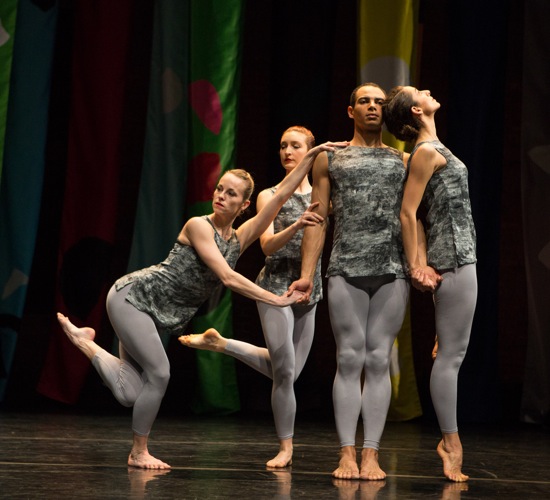
L to R): Solene Herault, Clara Freschel, Adrien Mornet, Flora Rogeboz in an Event staged by Robert Swinston for Compagnie CNDC-Angers. Photo: Yi-Chun Wu
When Merce Cunningham decided that his company should be disbanded two years after his death, it wasn’t entirely clear what he expected to happen to the nearly 200 dances that he had made over the course of five decades. Some, of course, had been lost along the way, but a good number had been filmed, and more were stored in the bodies of dancers who had performed them. The good news is that Cunningham’s remarkable dances are not all going to vanish from the town that nourished them. Beginning on March 25, this season’s “Juilliard Dances Repertory” pairs his Biped (1999) with Martha Graham’s Dark Meadow (1946). When the Stephen Petronio Company begins its season at the Joyce Theater on April 5, Cunningham’s RainForest (1968) will be performed alongside Petronio’s own works.
And this week, the Joyce has hosted a guest from abroad, Compagnie CNDC-Angers, in a Cunningham Event put together by Robert Swinston, the company’s artistic director and a stalwart of the Merce Cunningham Dance Company from 1980 until its demise in 2011. Like all such Events, this one is an assemblage of excerpts drawn from Cunningham dances (joined together or layered), given uniform new costumes and décor, set to a new live score, and lasting about an uninterrupted 75 minutes.
Cunningham’s work has always been greatly admired in France, and it is intriguing to see it delivered with a slight French accent. The eight dancers’ light gray tights and mottled darker gray tunics are by Michelle Amet and the vividly colored, boldly patterned panels that flank the stage on three sides are by master kite designer Jackie Matisse (the painter’s granddaughter). The dancers were raised and trained in France. The expert and daring musicians, however, are Americans: John King (composer, guitarist, violist) and Gelsey Bell (singer, songwriter, scholar).
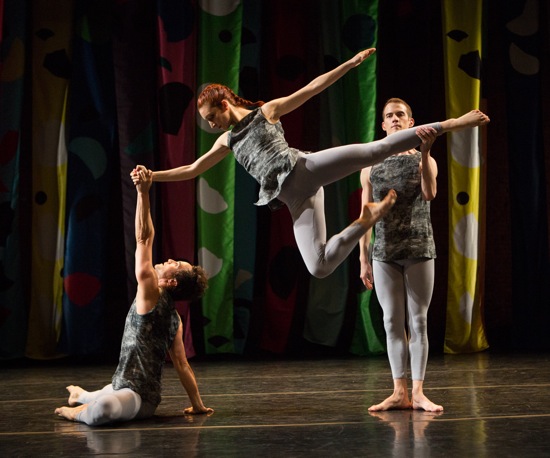
(L to R) Gianni Joseph, Clara Freschel, and Lucas Viallefond in the Cunningham Event at the Joyce Theater. Photo: Yi-Chun Wu
Merce Cunningham often spoke of the space in a dance as an open field. Although the term is one used in physics, I have often thought of his works in relation to actual fields. Sit gazing at one for a while, and you’ll see nature’s apparently random (athough rationally founded) arrangements. Stalks of mullein rising from a place where digging has been done, marsh mallows in a damp place, yellow mustard scattered, blue chickory blooming at the road’s edge. These are static images, of course, but sun’s angle and wind and birds and animals change the picture.
In a Cunningham dance, as in such a field, there’s no hierarchy of events like those that exist in classical ballet. Actions happen in corners, center stage is not the place to which your eye is guided, and often there’s more going on than you can easily take in. That said, despite the diverse individual qualities of the dancers, there’s only one kind of mammal in a Cunningham “field.”
The Angers dancers, like those before them, have preternaturally active feet and legs, often as turned out from the hips as any ballet dancer’s. Those feet can stitch dense textures into the floor with the quick down-up-up passage across it (a waltz without the swooniness) or cross-and-open steps in place. Their legs fly high and straight and crank into a bend like ballet’s passé. But on top of this busy base, their bodies can bend and twist and curve and arch, and their arms whip into various shapes. Standing meditatively on one leg, a dancer can modify his/her position as if deciding what sculptural image to form. Cunningham dancers can appear rash, even, at times, reckless (he certainly did, and often), but they are intrinsically Apollonian; few Dionysian storms interrupt their serenity or knock them off balance.
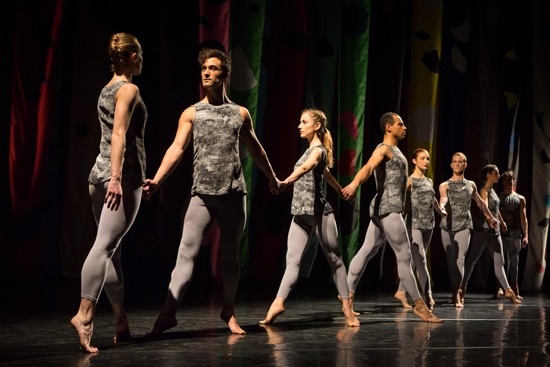
Compagnie NCDC-Angers (L to R): Solene Herault, Gianni Joseph, Anna Chirescu, Adrien Mornet, Clara Freschel, Lucas Viallefond, Flora Rogeboz, Alexandre Tondolo. Photo: Yi-Chun Wu
The Event that I saw on March 12, the second night of CNDC-Angers’ Joyce season, begins with a vista of the panels, blown gently by unseen fans. Into this already alive, unpredictable space, the dancers walk unhurriedly, one by one, into a diagonal line, and plant their feet wide apart: Gianni Joseph, Alexandre Tondolo, Anna Chirescu, Lucas Viallefond, Flora Rogeboz, Clara Freschel, Adrien Mornet, Solene Herault. Musical burps from King’s console precede them, and Bell begins to emit some of the many manipulated sounds she can initiate with her voice (later she lets us hear the untampered-with loveliness of her soprano). Suddenly, the dancers take hands to form a chain. The moment is a startling one; they have gauged their relative positions so accurately that no leaning out is necessary: from motionless separation to a collaborative formation by means of instant, accurate gestures by everyone’s arms.
As four dancers form a quartet and others exit, you notice a quality—or perhaps function is a better word—that will color the whole Event. When dancers are not alone onstage, they are prepared to serve others or to be used by them for support—always aware (whether they indicate this or not) that someone needs a hand to lean against or has provided an arch that invites someone else to duck through. This is their day-to-day business, and they enact it with full concentration but no emotional content. They do not intend to rouse narrative expectations among the audience members.
This doesn’t mean that we don’t see “situations” in what these superbly strong, agile human beings do together. Early on, three people (Mornet, Tondolo, and Herault) hold hands, while Chirescu (the smallest of the four women) scurries around and between them. She clings to Mornet while he manipulates Herault, and Mornet somehow turns Chirescu while she’s piggybacked on Tondolo. The other dancers sit in corner pools of light and scrutinize this.
The music thickens and thins, becomes fiercely loud and suddenly sweetens, becoming for an instant almost tonal (Cunningham’s partner and radical music director, composer John Cage, could tolerate both din and quiet). For a moment, when Chirescu, Joseph, and Tondolo are dancing in leggy unison, I think I hear something like church bells in disguise, then Bell’s high voice. During a longer duet for Joseph and Herault, the musicians create clanking sounds, then crackling ones. Squawking comes out of the speaker to my right. The volume increases. But all this time, the dancers proceed calmly. Herault bends back, and Joseph raises his arms for her to lean on. It seems to matter that they return to a side-by-side position with their front legs lifted and bent slightly. He looks at her, rotates her, very gently presses her lifted arms down to her sides. The music becomes calm, but, in contrast, the two dancers erupt, wrenching themselves around, their limbs like quick knives, Joseph’s mop of curly hair flying.
There’s a wealth of things to look at as the Event progresses: two dissimilar duets coexisting; people passing through, quickly or at a leisurely pace; several dancers assembling to create a structure dependent on its individual parts; a sudden coalescing into quick-footed unison; two quartets playing at counterpoint. And throughout, all manner of vigorous arguments with gravity: leaps, hops, jumps, and small springy steps.
The duets are intriguing in the ways in which the two dancers express being together. In one of these pairings, you see an interplay of straight lines and angles; one of Freschel’s hands is on her hip, and Joseph sticks his straight arm through the opening as if that was a natural move like reaching into a cupboard to take out the jam. Bell sings very sweetly while the two compare angles and straight lines, but seldom curves. In a later duet between Rogeboz and Mornet, the performers’ arms are often straight, but he keeps worming his body around to nestle close to hers.
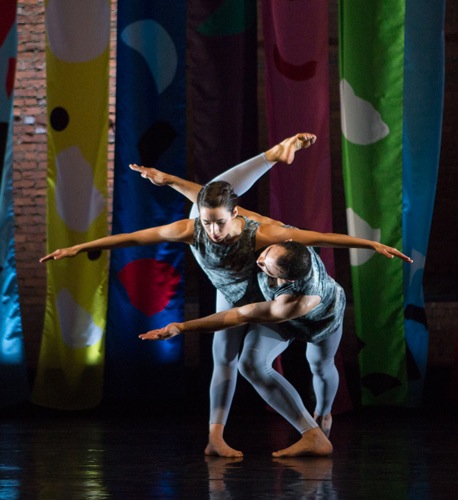
Flora Rogeboz and Adrien Mornet in the Cunningham Event staged by Robert Swinston. Photo: Yi-Chun Wu
In one of the most reckless vignettes, Chirescu takes on all four men. They toss her in the air. When she crouches to pull back against their hands, she’s catapulted aloft. But when the men stand in a tight circle around her and yearn to jump, she holds each one’s hand as he does so. Herault replaces her for another big toss, and later, when she (Herault) is lifted she reaches for the remaining men’s raised hands the way you’d reach from a carousel to try for the golden ring that would grant you a free ride.
The excerpts included in the week’s Events were drawn and adapted by Swinston from eleven Cunningham dances dating from 1965 to 1990. A Cunningham expert could probably identify each one, but that’s not the way I wanted to watch the performance. I wanted to let my eyes ramble and to admire the individual dancers—their technical expertise, a certain unaffected elegance, and their commitment to choreography that requires stamina and intent focus. I think it’s not easy to perform every movement fully in the deepest sense of that adverb, while also refraining from overplaying it or layering an emotion onto it. Some of the Angers dancers, in trying to steer clear of the latter, don’t always find the sweet spot. I found my gaze often drawn to Chirescu because of the quality of her attention. She was there doing this at this moment with all the clarity of intention and openness of someone discovering and inhabiting these movements for the first time.
Cunningham is in town. Can Spring be far behind?

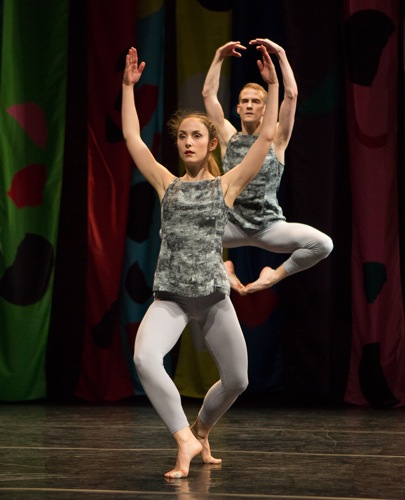
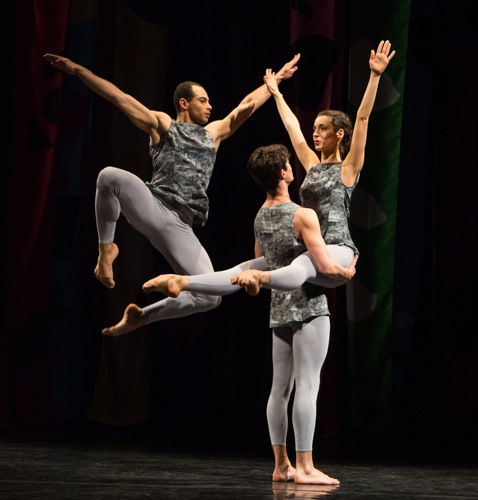
What a beautiful, very visual and physical review! It must have been a thrilling evening. Thank You Ms. Jowitt.
And thank you, Robert Swinston! What a superb way to honor a great choreographer.